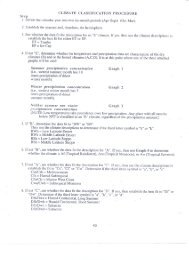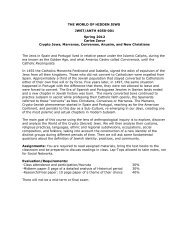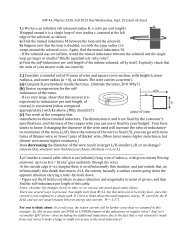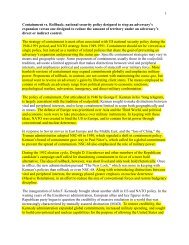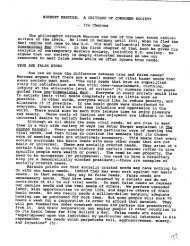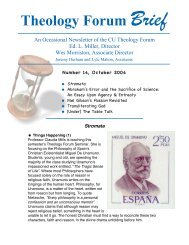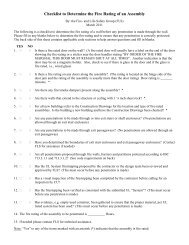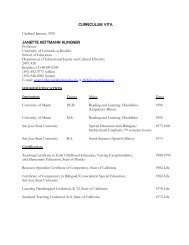An single electron bashes into an atom in a discharge lamp If atom ...
An single electron bashes into an atom in a discharge lamp If atom ...
An single electron bashes into an atom in a discharge lamp If atom ...
You also want an ePaper? Increase the reach of your titles
YUMPU automatically turns print PDFs into web optimized ePapers that Google loves.
<strong>An</strong> <strong>s<strong>in</strong>gle</strong> <strong>electron</strong> <strong>bashes</strong> <strong><strong>in</strong>to</strong> <strong>an</strong> <strong>atom</strong> <strong>in</strong> a <strong>discharge</strong> <strong>lamp</strong><br />
Electron leaves hot filament with<br />
nearly zero <strong>in</strong>itial k<strong>in</strong>etic energy<br />
10 V<br />
-10eV<br />
<strong>If</strong> <strong>atom</strong> fixed at the center of the tube,<br />
list all the possible photon energies (colors) that you might see?<br />
A. 1eV, 2eV, 3eV, 4eV, 7eV, 8eV<br />
B. 4eV, 7eV, 8eV<br />
C. 1eV, 3eV, 4eV<br />
D. 4eV<br />
E. Impossible to tell.<br />
-<br />
+<br />
-2 eV<br />
-3 eV<br />
-6 eV
<strong>An</strong> <strong>s<strong>in</strong>gle</strong> <strong>electron</strong> <strong>bashes</strong> <strong><strong>in</strong>to</strong> <strong>an</strong> <strong>atom</strong> <strong>in</strong> a<br />
<strong>discharge</strong> <strong>lamp</strong><br />
d<br />
-<br />
10 V<br />
+<br />
D<br />
-2 eV<br />
-3 eV<br />
-6 eV<br />
<strong>If</strong> <strong>atom</strong> fixed at this po<strong>in</strong>t <strong>in</strong> tube,<br />
-10eV<br />
list all the possible photon energies (colors) that you might see?<br />
A. 1eV, 2eV, 3eV, 4eV, 7eV, 8eV<br />
B. 4eV, 7eV, 8eV<br />
C. 1eV, 3eV, 4eV<br />
D. 4eV <strong>An</strong>swer is D. Electron only ga<strong>in</strong>s about 5eV!<br />
E. Impossible to tell.<br />
Electron energy = qV = e(Ed),<br />
where E is the electric field = (battery V)/(total dist<strong>an</strong>ce D),<br />
<strong>an</strong>d d is the dist<strong>an</strong>ce it goes before a collision.
<strong>An</strong>nouncements<br />
• Read<strong>in</strong>g next class F<strong>in</strong>ish chapter 5.<br />
• Homework 7 assigned today.<br />
• Exam 2 next week (Thursday)<br />
– Old Exam up today on CULearn.<br />
– List of topics up today on CULearn
Bohr, Moseley, <strong>an</strong>d<br />
Fr<strong>an</strong>ck/Hertz
Balmer/Rydberg had a mathematical formula to describe<br />
hydrogen spectrum, but no mech<strong>an</strong>ism for why it worked!<br />
Why does it work?<br />
410.3 486.1 Balmer’s formula 656.3 nm<br />
434.0<br />
<br />
91.<br />
19nm<br />
1 1<br />
2 2<br />
m n<br />
<br />
where m=1,2,3<br />
<strong>an</strong>d where n = m+1, m+2<br />
Hydrogen energy levels<br />
m=1, n=2
The Balmer/Rydberg formula is a<br />
mathematical representation of <strong>an</strong><br />
empirical observation.<br />
It doesn’t expla<strong>in</strong> <strong>an</strong>yth<strong>in</strong>g, really.<br />
How c<strong>an</strong> we calculate the energy levels<br />
<strong>in</strong> the hydrogen <strong>atom</strong>?<br />
A semi-classical expl<strong>an</strong>ation of the<br />
<strong>atom</strong>ic spectra (Bohr model)
Bohr Model<br />
• When Bohr saw Balmer’s formula, he came up<br />
with a new model that would predict it <strong>an</strong>d<br />
'solve' the problem of <strong>electron</strong>s spiral<strong>in</strong>g <strong><strong>in</strong>to</strong><br />
the nucleus.<br />
• The Bohr model has some problems, but it's<br />
still useful.<br />
• Why doesn’t the <strong>electron</strong> fall <strong><strong>in</strong>to</strong> the nucleus?<br />
– Accord<strong>in</strong>g to classical physics, It should!<br />
– Accord<strong>in</strong>g to Bohr, It just doesn’t.<br />
– Modern QM will give a satisfy<strong>in</strong>g <strong>an</strong>swer, but you’ll<br />
have to wait a little longer.<br />
Orig<strong>in</strong>al paper: Niels Bohr: On the Constitution of Atoms <strong>an</strong>d Molecules,<br />
Philosophical Magaz<strong>in</strong>e, Series 6, Volume 26, p. 1-25, July 1913.)
Bohr's approach:<br />
#1: Treat the mech<strong>an</strong>ics classical (<strong>electron</strong> sp<strong>in</strong>n<strong>in</strong>g around<br />
a proton):<br />
- Newton's laws assumed to be valid<br />
- Coulomb forces provide centripetal acceleration.
Electrostatic potential energy<br />
Potential energy of a <strong>s<strong>in</strong>gle</strong> <strong>electron</strong> <strong>in</strong> <strong>an</strong> <strong>atom</strong><br />
PE of <strong>an</strong> <strong>electron</strong> at dist<strong>an</strong>ce r from the proton is<br />
, ke2 2<br />
ke<br />
PE <br />
= 1.440eV·nm<br />
r<br />
+ + PE = -ke(Ze)<br />
+ r<br />
+ (For Z protons)<br />
potential<br />
energy<br />
0<br />
dist<strong>an</strong>ce from proton
Bohr Model. # 1: Classical mech<strong>an</strong>ics<br />
The centripetal acceleration<br />
a = v 2 / r is provided by the coulomb<br />
force F = k·Ze 2 /r 2 .<br />
(k = 1/( 4πε 0 ): Coulomb force const.)<br />
Newton's second law mv 2 /r = k·e 2 /r 2<br />
or: mv 2 = k·Ze 2 /r<br />
The <strong>electron</strong>'s k<strong>in</strong>etic energy is KE = ½ m v 2<br />
The <strong>electron</strong>'s potential energy is PE = - kZe 2 /r<br />
E= KE + PE = -½ kZe 2 /r = ½ PE<br />
Therefore: <strong>If</strong> we know r, we know E <strong>an</strong>d v, etc…<br />
F=k e 2 /r 2<br />
v<br />
+ E
<strong>An</strong>gular Momentum…<br />
<strong>An</strong> <strong>electron</strong> is orbit<strong>in</strong>g a proton at a radius r.<br />
What is its <strong>an</strong>gular momentum?<br />
a) m enr <strong><strong>in</strong>to</strong> the board<br />
b) m en out of the board<br />
c) m en o the right<br />
d) m en <strong><strong>in</strong>to</strong> the board<br />
e) m enr po<strong>in</strong>ted out of the board<br />
<strong>An</strong>gular momentum
Bohr's approach:<br />
#1: Treat the mech<strong>an</strong>ics classical (<strong>electron</strong> sp<strong>in</strong>n<strong>in</strong>g around<br />
a proton):<br />
- Newton's laws assumed to be valid<br />
- Coulomb forces provide centripetal acceleration.<br />
#2: Bohr's hypothesis (Bohr had no proof for this; he just<br />
assumed it – leads to correct results!):<br />
- The <strong>an</strong>gular momentum of the <strong>electron</strong>s is qu<strong>an</strong>tized <strong>in</strong><br />
multiples of ћ.<br />
- The lowest <strong>an</strong>gular momentum is ћ.<br />
ћ = h / 2π
Bohr Model. #2: Qu<strong>an</strong>tized <strong>an</strong>gular momentum<br />
Bohr postulated that the <strong>an</strong>gular<br />
momentum of the <strong>electron</strong> could only<br />
have the qu<strong>an</strong>tized values of:<br />
L= nћ<br />
<strong>An</strong>d therefore: mvr = nћ, (n=1,2,3…)<br />
or: v = nћ/(mr)<br />
Substitut<strong>in</strong>g this <strong><strong>in</strong>to</strong> mv 2 = k·e 2 /r :<br />
m(nћ/(mr)) 2 =k·Ze 2 /r: Solve for r <strong>an</strong>d get:<br />
rn 2<br />
rBn<br />
, with rB<br />
<br />
2<br />
2<br />
ke<br />
m<br />
2<br />
2 m(<br />
ke )<br />
En ER<br />
/ n , with ER<br />
2<br />
2<br />
52.<br />
9pm<br />
F=k e 2 /r 2<br />
, r B: Bohr radius Z=1<br />
2<br />
<br />
13.<br />
6<br />
eV<br />
v<br />
, E R: Rydberg<br />
Energy
Bohr Model. Results<br />
2<br />
r rBn<br />
, with rB<br />
<br />
2<br />
2<br />
ke<br />
, r B: Bohr radius<br />
m<br />
2<br />
2 m(<br />
ke )<br />
En ER<br />
/ n , with ER<br />
2<br />
2<br />
52.<br />
9pm<br />
2<br />
<br />
13.<br />
6<br />
eV<br />
, E R: Rydberg<br />
Energy<br />
The Bohr model not only predicts a reasonable <strong>atom</strong>ic radius<br />
r B, but it also predicts the energy levels <strong>in</strong> hydrogen to 4 digits<br />
accuracy!<br />
Possible photon energies: 1 1 <br />
E En<br />
Em<br />
ER<br />
2 2 <br />
m n <br />
(n > m)<br />
The Bohr model 'expla<strong>in</strong>s' the Rydberg formula!!
Only discrete energy levels possible.<br />
Electrons hop down towards lowest level, giv<strong>in</strong>g off photons<br />
dur<strong>in</strong>g the jumps. Atoms are stable <strong>in</strong> lowest level.<br />
potential<br />
energy<br />
0 dist<strong>an</strong>ce from proton<br />
Lm<strong>in</strong><br />
<br />
<br />
Bohr couldn't expla<strong>in</strong> why the <strong>an</strong>gular<br />
momentum is qu<strong>an</strong>tized but his<br />
model lead to the Rydberg-Balmer<br />
formula, which matched to the<br />
experimental observations very well!<br />
He also predicted <strong>atom</strong>ic radii reasonably well <strong>an</strong>d<br />
was able to calculate the Rydberg const<strong>an</strong>t.
Successes of Bohr Model<br />
• 'Expla<strong>in</strong>s' source of Balmer formula <strong>an</strong>d predicts<br />
empirical const<strong>an</strong>t R (Rydberg const<strong>an</strong>t) from<br />
fundamental const<strong>an</strong>ts: R= 1 / 91.2 nm=mk 2 e 4 /(4c 3 )<br />
Expla<strong>in</strong>s why R is different for different <strong>s<strong>in</strong>gle</strong><br />
<strong>electron</strong> <strong>atom</strong>s (called hydrogen-like ions).<br />
• Predicts approximate size of hydrogen <strong>atom</strong><br />
• Expla<strong>in</strong>s (sort of) why <strong>atom</strong>s emit discrete spectral<br />
l<strong>in</strong>es<br />
• Expla<strong>in</strong>s (sort of) why <strong>electron</strong> doesn’t spiral <strong><strong>in</strong>to</strong><br />
nucleus
Which of the follow<strong>in</strong>g pr<strong>in</strong>ciples of classical<br />
physics is violated <strong>in</strong> the Bohr model?<br />
A. Opposite charges attract with a force <strong>in</strong>versely<br />
proportional to the square of the dist<strong>an</strong>ce between<br />
them.<br />
B. The force on <strong>an</strong> object is equal to its mass times its<br />
acceleration.<br />
C. Accelerat<strong>in</strong>g charges radiate energy.<br />
D. Particles always have a well-def<strong>in</strong>ed position <strong>an</strong>d<br />
momentum.<br />
E. All of the above.<br />
Note that both A & B are used <strong>in</strong> derivation of Bohr model.
Moseley.
Basic questions<br />
1. Does the Bohr model tell us <strong>an</strong>yth<strong>in</strong>g else? Is it <strong>an</strong>yth<strong>in</strong>g<br />
more th<strong>an</strong> <strong>an</strong> oddity that expla<strong>in</strong>s Hydrogen?<br />
2. All of the <strong>in</strong>teractions we’ve seen <strong>in</strong> connection with<br />
“qu<strong>an</strong>tization” <strong>in</strong>volves light. Is “qu<strong>an</strong>tization” a property of<br />
light alone?
Balmer-Rydberg <strong>an</strong>d Bohr<br />
v<br />
<br />
91.<br />
19nm<br />
1 1<br />
2 2<br />
m n<br />
<br />
L= nћ<br />
mvr = nћ, (n=1,2,3…)<br />
<br />
ke<br />
rn 2<br />
rBn<br />
, with rB<br />
<br />
2<br />
2<br />
m<br />
2<br />
2 m(<br />
ke )<br />
En ER<br />
/ n , ER<br />
2<br />
2<br />
2<br />
<br />
52.<br />
9<br />
<br />
pm<br />
13.<br />
6eV<br />
Hydrogen energy levels<br />
m=1, n=2
Hydrogen like <strong>an</strong>d Electron<br />
2<br />
<br />
/ Z,<br />
with r 2<br />
ke m<br />
2<br />
rn rBn<br />
B<br />
2<br />
En Z<br />
ER<br />
R<br />
2<br />
2 m(<br />
ke )<br />
/ n , E 2<br />
2<br />
2<br />
shells<br />
<br />
<br />
52.<br />
9<br />
pm<br />
13.<br />
6eV<br />
As more <strong>an</strong>d more <strong>electron</strong>s are added<br />
they fill up <strong>in</strong> a particular order<strong>in</strong>g (more<br />
on this later)<br />
Import<strong>an</strong>t fact: only 1 <strong>electron</strong> per<br />
allowed state<br />
The closest ones (core <strong>electron</strong>s) are<br />
bound quite similarly to this equation.<br />
For Hydrogen like <strong>atom</strong>s<br />
(one <strong>electron</strong>)
How do we make x-rays?<br />
High velocity<br />
KE > 1 keV
How do we make x-rays?<br />
Knocks out a core <strong>electron</strong> <strong>an</strong>d then moves on.<br />
Do we know <strong>an</strong>yth<strong>in</strong>g about KE or KE?<br />
No. We c<strong>an</strong> but we don’t
How do we make x-rays?<br />
Level 2 <strong>electron</strong> falls <strong><strong>in</strong>to</strong> empty state releas<strong>in</strong>g photon<br />
This process produces someth<strong>in</strong>g called a K x-ray<br />
What is the energy of such a photon?
Basic experimental setup
X-ray energies (K-a l<strong>in</strong>e)<br />
The energy scales are<br />
likely related to the<br />
Bohr model.<br />
What is the charge<br />
seen by the bound<br />
<strong>electron</strong>s?
Moseley Balmer <strong>an</strong>d Rydberg<br />
This <strong>electron</strong> sees what<br />
charge from the nucleus?<br />
Turns out we c<strong>an</strong> ignore <strong>an</strong>y<br />
<strong>electron</strong>s outside this.<br />
a) Ze b) (Ze) 2<br />
c) e(Z-2) d) e(Z-1)
Moseley Balmer <strong>an</strong>d Rydberg<br />
This <strong>electron</strong> sees what<br />
charge?<br />
a) Ze b) (Ze) 2<br />
c) e(Z-2) d) e(Z-1)<br />
Nucleus has Z charge <strong>an</strong>d one<br />
<strong>electron</strong> is screen<strong>in</strong>g it. So<br />
e(Z-1)
Implications<br />
All <strong>atom</strong>s measured agree with Balmer, Rydberg <strong>an</strong>d Bohr<br />
with only slight modifications.<br />
With only slight modifications this expla<strong>in</strong>s other x-ray<br />
spectral l<strong>in</strong>es<br />
L<strong>an</strong>th<strong>an</strong>ide series: M<strong>an</strong>y elements “discovered” but<br />
chemistry wasn’t yet enough to sort them all out.<br />
Moseley’s work ordered them, found how m<strong>an</strong>y there were,<br />
<strong>an</strong>d predicted miss<strong>in</strong>g elements (promethium).<br />
"You see actually the Rutherford work [the nuclear <strong>atom</strong>] was not taken seriously.<br />
We c<strong>an</strong>not underst<strong>an</strong>d today, but it was not taken seriously at all. There was no<br />
mention of it <strong>an</strong>y place. The great ch<strong>an</strong>ge came from Moseley.“ N. Bohr.







